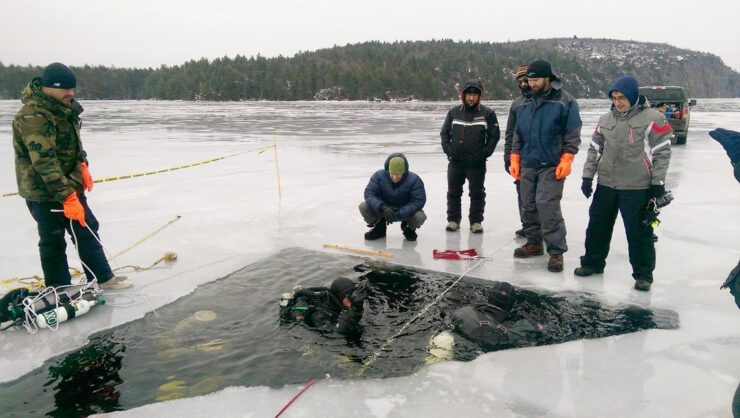Brown dove 132m under ice, searching for Indigenous artifacts
University of Ottawa anthropology master’s student Kevin Brown broke the world record for deepest ice dive at 132 metres beneath the surface, in an exploratory dive in Mazinaw Lake in late January while searching for underwater Indigenous artifacts, his area of research.
“We realized (Lake Mazinaw) was so deep that probably no other diver went there before, so most likely everything the (First Nations) people would have dropped would still be in the water,” Brown said. “One of the guys, at one point said, ‘You know, if you do that, you’ll probably be the first people going to that depth.’ We looked online and realized we were actually breaking the record.”
Breaking a depth record is, of course, not without its problems.
“You’re very alone down there,” Brown said of being at 130 metres underwater. “The pressure is so strong that it pushes at your nervous system … the pressure is basically screwing up your nervous system. The density of the air is also thickening due to the pressure.”
There are many dangers associated with diving to those depths, especially in cold water. Decompression sickness, also known as “the bends,” is the most common diving-related hazard, and occurs when a diver ascends too quickly. Nitrogen bubbles get into the bloodstream and joints, and in severe cases can cause paralysis or circulatory shock.
To avoid decompression sickness, divers must ascend slowly, which increases the chance of hypothermia in cold waters like those in Mazinaw Lake. Although Brown was only at a depth of 132 metres for eight minutes, the total dive time was over two hours in freezing water.
“You need to stay in the water—if you exit you’re going to get decompression sickness and most likely die, but if you stay in the water you’re going to be hit with hypothermia and you might end up passing out,” Brown explained.
There’s also the chance of a deadly increase in CO2 at such depths, which can knock a person unconscious.
Brown has been diving since public school, and is a founding member of PTO Exploration, a technical diving outfit based in Ottawa. Although he now dives for academic research, he has been doing serious exploration diving for about a decade. As Brown puts it, anyone who dives at a high level will get into exploration diving eventually, as they try to push the limits of their abilities.
“Any diver who stays long enough in the field will do it,” said Brown. “You reach a place in diving where you want to go deeper or longer, but there’s no more classes for that.”
While Brown might be getting a lot of the coverage, the dive wasn’t a one-man affair. He dives with a team of about 10 others who make the explorations possible.
“It’s a team effort, and without them I wouldn’t be able to do anything,” Brown said. This dive isn’t a personal record, Brown stressed, but a “team record.”
Diving might seem like something people do for fun on Caribbean vacations, but Canada has world-class diving spots of its own. Diving is easy to get into, Brown said. All dive shops offer classes, from beginner to advance levels.
“Some of the spots in Canada are the best in the world for diving,” Brown said.
Although they came up empty-handed, Brown and his team are planning a larger, two-week expedition looking for shipwrecks in the Arctic Ocean this summer.







